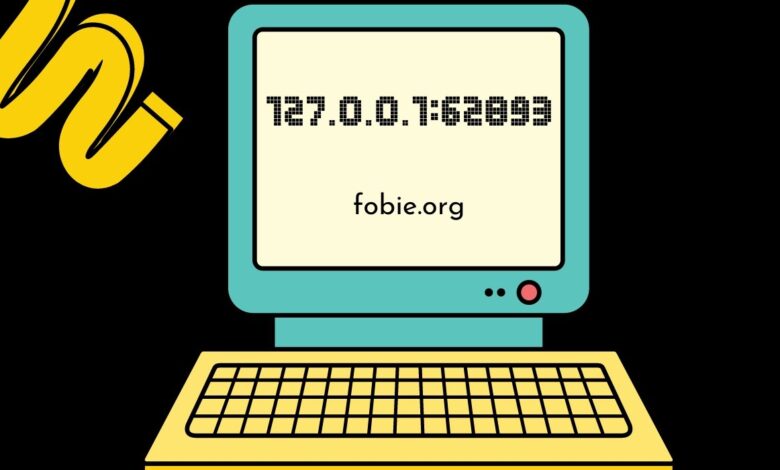Unlocking the Mystery of 127.0.0.1:62893: A Beginner’s Guide

Table of Contents
Understanding 127.0.0.1:62893
When you hear the term 127.0.0.1:62893, you might wonder what it refers to. In the simplest terms, this is an IP address paired with a port number. The IP address 127.0.0.1 is known as the loopback address, which means it is used to refer back to your own computer. The port number 62893 specifies a particular service or application running on your device.
Firstly, understanding the loopback address is crucial. It allows your computer to communicate with itself. This is particularly useful for testing and development purposes. Meanwhile, the port number helps ensure that the data goes to the right place within your machine.
What Does 127.0.0.1:62893 Do?
To elaborate, when you connect to 127.0.0.1:62893, you may be accessing a web server or an application that is running locally. For example, developers often use this configuration to test websites before they go live. This means that you can see how the site behaves without actually uploading it to the internet.
Moreover, using the loopback address can prevent potential issues with firewalls or network configurations. Since the communication is happening within your own computer, you can bypass many external security settings. Thus, it’s a handy tool for developers and tech enthusiasts alike.
The Importance of IP Addresses
What is an IP Address?
An IP address is like a home address for your computer on the internet. It helps devices find each other and communicate. The IP address 127.0.0.1 is special because it always points back to your own machine.
In addition, IP addresses can be either IPv4 or IPv6. The former consists of four numbers separated by periods, while the latter includes a longer string of hexadecimal characters. 127.0.0.1 is a common IPv4 address.
Why Use 127.0.0.1:62893?
By using 127.0.0.1:62893, you can run multiple tests on different applications without affecting anything on the internet. This is incredibly useful for developers who need to ensure their applications work correctly.
Furthermore, it allows you to experiment with different configurations without the risk of breaking anything live. For instance, if you are testing a new feature in a web application, using this setup ensures that only you can see the changes.
The Role of Port Numbers
What are Port Numbers?
Port numbers are like doors to your computer. Each door allows different types of data to enter or exit. The number 62893 in 127.0.0.1:62893 is a specific door that an application can use to communicate.
Also, there are well-known port numbers for common services, like HTTP (port 80) or HTTPS (port 443). However, developers often use higher numbered ports, like 62893, for their custom applications.
How to Find Available Port Numbers
Finding available port numbers can be straightforward. You can use tools like netstat to check which ports are currently in use. By ensuring that you pick an unused port, you can avoid conflicts with other applications.
Moreover, if you accidentally choose a port that is already in use, you might encounter errors. Therefore, always verify the current port status before starting your application.
Setting Up a Local Server
Why Set Up a Local Server?
Setting up a local server using 127.0.0.1:62893 can simplify your development process. It allows you to test your applications quickly. Furthermore, you have complete control over the server environment.
In addition, a local server can help you debug issues more effectively. Since everything runs on your machine, you can easily access logs and error messages. This can significantly speed up the development process.

Steps to Set Up a Local Server
To set up a local server, you need a few tools. First, you’ll need a web server software like Apache or Nginx. After that, configure it to listen on 127.0.0.1:62893.
Once everything is set up, you can open a web browser and type in http://127.0.0.1:62893 to access your server. This will allow you to see your application in action.
Common Issues with 127.0.0.1:62893
Troubleshooting Connection Problems
Sometimes, you may experience issues connecting to 127.0.0.1:62893. One common problem is that the server might not be running. Always check that your server software is active.
Moreover, firewall settings can block access to certain ports. If you encounter issues, ensure that your firewall allows connections to 62893. Checking these settings can often resolve many problems.
Performance Issues
In addition to connectivity problems, you might face performance issues. If your application runs slowly, it may be due to heavy resource usage. Check if your computer’s CPU or memory is being overutilized.
Furthermore, optimizing your application’s code can help improve performance. Sometimes, simple adjustments can make a significant difference in how your application runs.
Security Considerations
Securing Your Local Server
While using 127.0.0.1:62893 is generally safe, you should still take precautions. Make sure your server software is up to date. This can help protect against vulnerabilities.
Additionally, consider using strong passwords for any services you run. Even though the server is local, security should never be overlooked.
Best Practices for Development
When developing applications, always follow best practices. For instance, regularly back up your work. This ensures that you won’t lose important data if something goes wrong.
Moreover, document your changes. Keeping track of what you’ve updated can help you troubleshoot issues more effectively.
Conclusion
In summary, understanding 127.0.0.1:62893 is essential for anyone interested in web development. This loopback address combined with a port number allows you to test and develop applications effectively.
By utilizing a local server setup, you can streamline your workflow and enhance your development process. Remember to keep security in mind and troubleshoot any issues that arise. Embracing these practices will lead you to become a more proficient developer.
READ MORE : Zachary Latham: 7 Valuable Lessons from His Controversial Life – A Cautionary




